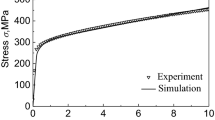Conclusions
The results of model experiments confirm the validity of the hypothesis that the plastic flow of material in the contact zone is a consequence of conservative motion of dislocations in the contact region. Before the capacity for mass transport by this mechanism and hence its contribution to “activity” can be reliably assessed, it will be necessary to examine the problem of possible dislocation multiplication in the peripheral zone of the contact. At present we can only assert that this capacity is not less than that due to dislocations linked with the previous history of a material. Under conditions of a model experiment this capacity is determined by the density of dislocations generated in the vicinity of the crack mouth during cleavage. In the case of ideally brittle fracture this density might prove to be equal to zero.
Similar content being viewed by others
Literature cited
Ya. E. Geguzin, The Physics of Sintering [in Russian], Nauka, Moscow (1967).
Ya. E. Geguzin, “Diffusion chromizing of porous crystalline structures,” Fiz. Tverd. Tela,17, No. 7, 1950–1954 (1975).
Ya. E. Geguzin, “Initial stage of ‘active’ sintering” superplasticity of a porous structure,” Dokl. Akad. Nauk SSSR,229, 601–603 (1976).
Ya. E. Geguzin and Yu. I. Klinchuk, “Mechanism and kinetics of the initial stage of solidphase sintering of compacts from powders of crystalline solids (sintering ‘activity’),” Poroshk. Metall., No. 7, 17–25 (1976).
J. J. Nunes, F. V. Lenel, and G. S. Ansell, “The influence of crystalline anisotropy on neck growth during the sintering of zinc,” Acta Metall.,19, 107–115 (1971).
Ya. E. Geguzin and V. G. Kononenko, “Diffusion-dislocation mechanism of sintering,” Fiz. Tverd. Tela,22, No. 9, 2661–2667 (1980).
Yu. I. Boiko, Ya. E. Geguzin, V. G. Kononenko, E. Friedrich, and W. Schatt, “Contact phenomena in a sphere-plane single-crystal system,” Proshk. Metall., No. 10, 14–24 (1980).
K. L. Johnson, “A note on the adhesion of elastic solids,” J. Appl. Phys.,9, No. 2, 199–201 (1958).
L. D. Landau and E. M. Lifshitz, Theory of Elasticity, Addision-Wesley (1971).
K. L. Johnson, A. K. Kendall, and A. D. Roberts, “Surface energy and the contacts of elastic solids,” Proc. R. Soc.,324, No. 1, 301–313 (1971).
S. P. Timoshenko and J. N. Goodier, Theory of Elasticity, McGraw-Hill (1970).
A. S. Tetelman and A. J. McEvily, “Fracture of structural materials,” J. Wiely, No. 1, 28–30 (1967).
Ya. E. Geguzin, N. N. Ovcharenko, and I. V. Vorob'eva, “Investigation of phenomena on single-crystal surfaces. Mechanisms and kinetics of healing of deep cracks on the surfaces of ionic crystals,” Kristallografiya,10, No. 3, 371–379 (1965).
R. I. Ray, A. W. Pawinich, and C. N. Ahlgwist, “On the sintering role of cleavage cracks,” Acta Metall.,23, No. 2, 399–405 (1975).
A. Lydyard, Ionic Conduction in Crystals [Russian translation], IL, Moscow (1962).
Author information
Authors and Affiliations
Additional information
Translated from Poroshkovaya Metallurgiya, No. 11(227), pp. 36–42, November, 1981.
Rights and permissions
About this article
Cite this article
Boiko, Y.I., Geguzin, Y.E. Model investigation of the dislocation mechanism of “active” sintering of crystalline solids. Powder Metall Met Ceram 20, 775–780 (1981). https://doi.org/10.1007/BF00796476
Received:
Issue Date:
DOI: https://doi.org/10.1007/BF00796476




